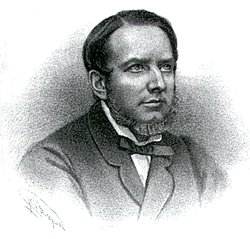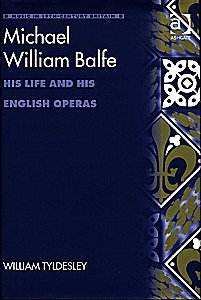
A new biography of composer Balfe has been long and eagerly awaited.
Three 19th century biographies were compiled, but these
were written more as an interesting narrative rather than documents
with a high density of facts. The results do not disappoint. Ashgate
are to be applauded for having included this title in their music
series alongside Music in 19th Century Britain and Light
Music in Britain since 1870. Renewed interest in Balfe is
timely as we near the Balfe bi-centenary in 2008 when hopefully
full-scale operas will be revived for the BBC Proms and elsewhere.
Currently, there are only two professional sources of Balfe's
music on CD: Bonynge's The Bohemian Girl (Argo, 1993; now
re-released on Decca, 2003), and Bonynge's delightful The Power
of Love (on Melba 301082, 1999) which carries nine ‘lost’
Balfe arias.
Michael Balfe was an important British
musician of his age. He was trained in the writing of opera in
Italy, was very much admired by Rossini, and was sought by Berlioz
to conduct one of his opera performances. Being a good baritone
himself, who sang opera both in Italy and France, he was so admired
by the singer, Malibran that even she wanted a part in of one
of his early operas. He wrote The Maid of Artois (1836)
as a vehicle for her. Operas of his were performed on the Continent
with vocal score translations printed in France, Germany and Italy.
He was supported by Bunn, Manager of the Theatre Royal, Drury
Lane and was commissioned by the Harrison-Pyne and Carl Rosa Opera
companies. For a short time Balfe also became a theatre manager
to promote an English Opera movement. When short of money his
wife Lina, a good soprano, would take leading roles alongside
himself in their productions.
William Tyldsley's elegantly written biography
covers all facets of Balfe, the composer: his travels and life;
his work as a singer and his associates; the state of the theatre
scene in the mid 19th Century; background to his librettists;
constructional detail of the operas, their plot, characteristics
and key structures; as well as the probable reasons for their
various successes or failures. This book is obviously the result
of much painstaking research into private collections and scrutiny
of the autograph scores both here and on the continent. Tyldsley
has checked the facts promoted by the previous biographers St
Ledger (1870), Kenny (1875) and Barrett (1882) and now provides
fresh answers. His research has been aided by the existence of
a near-complete set of autograph scores and letters, passed by
Balfe's widow, Lina, to the British Museum. These were unavailable
to the previous biographers and so Tyldesley's information turns
out to be both interesting and revealing. We find that even a
facsimile list of operas made in Balfe's own hand (facsimiled
in Kenny) is inaccurate.
The author is a first rate musician who is able
to put Balfe's compositions into perspective with other composers
and say why certain arias/ballads appeal. And Tyldsley knows his
opera and cross-references musical passages with those of other
composers to reveal similarities or differences. Being able to
make parallels with works of the Italian and French schools or
G&S is useful as it allows the reader to get a better feel
for the music they have never heard. Evidence shows that Balfe
was a fast worker, using shorthand cuts, and often acted hurriedly
to finish a score. Surprisingly, he would add/subtract numbers
or provide different keys to suit an artiste's wishes. An unorthodox
presentation of some of the autograph scores used the common 12
stave manuscript paper available at the time, necessitating woodwind
lines to be bound in at the back, thus making it impossible to
use the master score by a conductor. The overtures tend not to
be bound with the full score. But why? Balfe, though short of
money, would not always bother to write out a score fully, but
would leave repeat signs and empty bars for a copyist who would
be expected to add bits of missing orchestration. Why pay for
this when he was often short of money?
An academic approach is taken to the analysis
of the important operas: this is highlighted by an in-depth examination
of Balfe's key structures within key operas: The Siege of Rochelle,
The Bohemian Girl, Rose of Castille and Satanella.
Discussed is Balfe's apparent inability to engage good librettists
and quite rightly the author criticises the short-comings of the
librettists, Fitzball and Bunn in providing unrealistic plots.
Yet Balfe seemed to be blind to their faults and continued to
work with them. Some of their gloomy and serious historical plots
for his early works were not properly worked out. Yet Balfe does
not help his librettists by suppressing realism through the addition
of happy endings whether it be for a character dying in the desert
(Maid of Artois) or burning at the stake (Joan of Arc).
A standard ending with Rondo and chorus does not aid the story
line.
The book is generous in its supply of musical
examples, yet lacks good photographic material. The covers of
quadrilles, lancers and arias taken from the operas often carry
illustrations of stage settings that would have amplified plot
descriptions and could have visually lifted the book. A few pages
of plates do occupy the centre pages as in the old style of presentation
(where gloss art paper is used to carry high definition pictures).
Here, medium definition printing is disappointingly provided on
the same paper as the rest of the book and so one wonders why
the centre spread of plates was used after all. A reader who has
the Bonynge CD (mentioned above) with its abundance of interesting
visual Balfian material will appreciate the lost opportunity here.
I particularly like the fact that Tyldsley gives
his opinions and shares his thoughts with the reader allowing
one to join him in puzzling things out. His clear and detailed
descriptions of the appearance of the material he has been working
from makes it unnecessary for anyone to consider a need to look
at the sources further. He tells us where the band parts can be
found, thus helping any group interested in performing the operas.
This biography replaces the previous ones. The reader feels he
is present during searches and William Tyldsley's lively descriptions
make the reading of his intriguing biography a joy.
Raymond Walker

